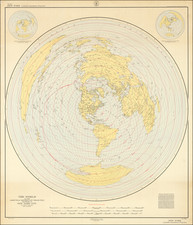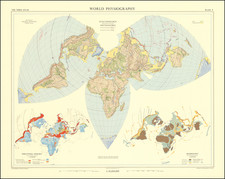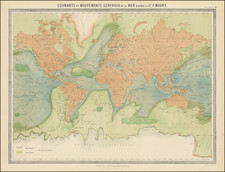Gerard Mercator's Map of the World, Based Upon The Work of Claudius Ptolemy
Gorgeous example of Mercator's map of the World, based upon the writings of Claudius Ptolemy, from a later edition of Gerard Mercator's Tabulae geographicae CI. Ptolemaei ad mentem autoris restitutae et emendatae per G. Mercatorem, first published in 1578.
This is the first state of Mercator's1578 Ptolemaic world map, with the strapwork around the map and 12 windheads. In the later editions, the border has been re-engraved, and now includes a frieze of allegorical figures representing the four elements of Fire (Zeus), Air (Hera), Water (Neptune), and Earth (Gaia), rather than the strapwork and windhead border of the earlier editions.
The map includes a massive Taprobana (modern day Sri Lanka) in the Indian Ocean. The Indian subcontinent is severely truncated and the Indian Ocean appears to be land locked. Only the northern part of Africa is shown with the Nile originating in the twin lakes south of the Equator in the Lunae montes (Mountains of the Moon).
While Mercator is perhaps best known for his modern maps and the map projection which bears his name, one of his life goals was to produce his own version of Ptolemy's Geographia. As a second installment of his Atlas sive Cosmographia . . ., Mercator published an authentic version of Ptolemy's seminal work, deliberately devoid of the distracting interpretations and misinterpretations by earlier editors intent on improving the Egyptian geographer's seminal work. Mercator's goal was an accurate portrait of Ptolemy's second-century view of the world. To understand the present, the mapmaker believed, one must appreciate the past.
The atlas, published in 1578, included Ptolemy's twenty-seven maps, carefully restored, handsomely engraved, and supplemented by an index of place names and an enlarged boundary map of the Nile Delta. A total of 8 editions were published between 1578 and 1730.
Gerard Mercator is one of the most famous cartographers of all time. Mercator was born in Flanders and educated at the Catholic University in Leuven. After his graduation in 1532, Mercator worked with Gemma Frisius, a prominent mathematician, and Gaspar a Myrica, a goldsmith and engraver. Together, these men produced globes and scientific instruments, allowing Mercator to hone his skills.
With his wife, Barbara, Mercator had six children: Arnold, Emerentia, Dorothes, Bartholomeus, Rumold, and Catharina. In 1552, Mercator moved to Duisburg from Leuven, where he lived for the rest of his life. In 1564, he was appointed the official cosmographer to the court of Duke Wilhelm of Cleve.
Mercator’s most important contribution was the creation and popularization of a projection which now bears his name. On Mercator projection maps, all parallels and meridians are drawn at right angles to each other, with the distance between the parallels extending towards the poles. This allowed for accurate latitude and longitude calculation and also allowed navigational routes to be drawn using straight lines, a huge advantage for sailors as this allowed them to plot courses without constant recourse to adjusting compass readings.
Mercator’s other enduring contribution to cartography is the term “atlas”, which was first used to describe his collection of maps gathered in one volume. The Mercator atlas was published in 1595, a year after Mercator’s death, thanks to the work of his sons, particularly Rumold, and his grandsons.









![Charte über die verschiedenen jezt auf der Erde herrschenden Religionen [Map on the various religions now ruling the earth]](https://storage.googleapis.com/raremaps/img/small/85202.jpg)

![[ Ancient World ] Aevi Veteris, Typus Geographicus](https://storage.googleapis.com/raremaps/img/small/85526.jpg)


